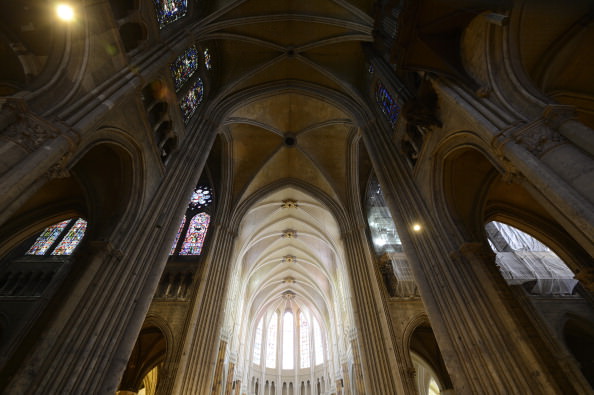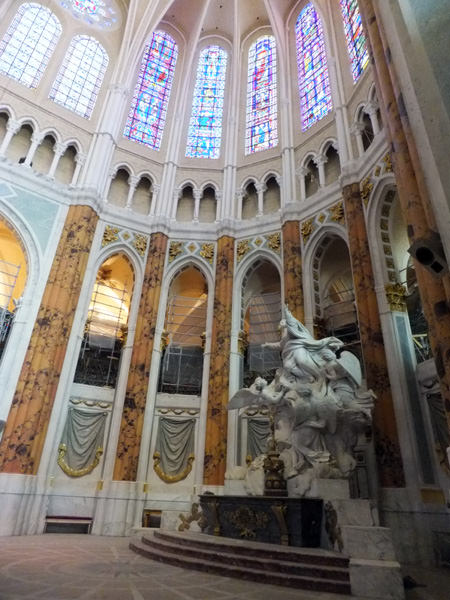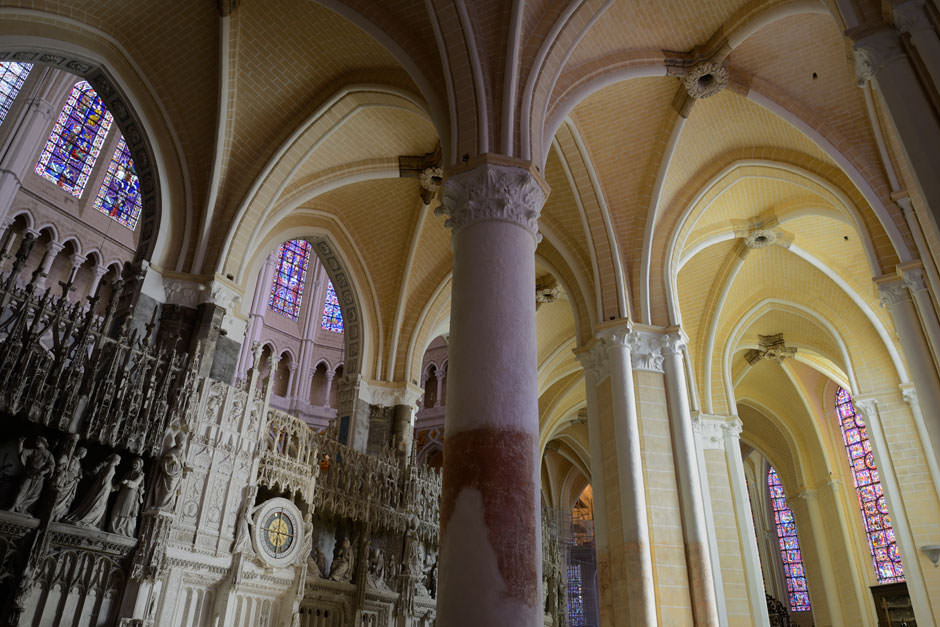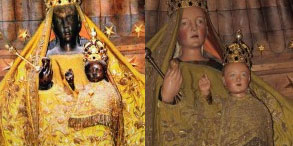Over a lifetime of looking at buildings, a few have stood out as soul-stirring experiences. High among them is Chartres Cathedral, which I first saw some thirty years ago. Though I had long been acquainted with this renowned Gothic landmark through photographs, I was quite unprepared for the visceral impact of its dark, soaring interior, especially the famous stained glass windows that glowed like precious gems set into the intricately carved stone walls. I began to understand how this overwhelming creation could be perceived as heaven on earth.
During a recent trip to Paris I decided it was time for a return visit, and on an autumn Sunday morning my wife, our friends, and I traveled sixty miles southwest of the French capital to take in this architectural wonder. It was crisp and sunny, perfect weather for viewing the celebrated vitraux, widely considered the finest in the world. As we entered the great church, which was largely constructed between 1194 and 1230, High Mass was in full swing—the scene heightened by the combination of majestic organ music, chanted liturgy, clouds of incense, and banks of votive candles.
Carried away by the splendors of the moment, I did not initially realize that something was very wrong. I had noticed the floor-to-ceiling scrim-covered scaffolding near the crossing of the nave and transepts, but had assumed it was routine maintenance. But my more attentive wife, the architectural historian Rosemarie Haag Bletter—who as a Columbia doctoral candidate took courses on Romanesque sculpture with the legendary Meyer Schapiro and Gothic architecture with the great medievalist Robert Branner—immediately noticed that large areas of the sanctuary’s deep gray limestone surface had been painted.
The first portion she pointed out was a pale ochre wall patterned with thin, perpendicular white lines mimicking mortar between masonry blocks. Looking upward we then saw panels of blue faux marbre, high above them gilded column capitals and bosses (the ornamental knobs where vault ribs intersect), and, nearby, floor-to-ceiling piers covered in glossy yellow trompe l’oeil marbling, like some funeral parlor in Little Italy.*
How could this be happening, and why had we heard nothing about it before?
In 2009, amid a rising wave of other refurbishments of medieval buildings, the French Ministry of Culture’s Monuments Historiques division embarked on a drastic, $18.5 million overhaul of the eight-hundred-year-old cathedral. Though little is specifically known about the church’s original appearance—despite small traces of pigment at many points throughout the interior stonework—the project’s leaders, apparently with the full support of the French state, have set out to do no less than repaint the entire interior in bright whites and garish colors that are intended to return the sanctuary to its medieval state. This sweeping program to “reclaim” Chartres from its allegedly anachronistic gloom is supposed to be completed in 2017.
The belief that a heavy-duty reworking can allow us see the cathedral as its makers did is not only magical thinking but also a foolhardy concept that makes authentic artifacts look fake. To cite only one obvious solecism, the artificial lighting inside the present-day cathedral—which no one has suggested removing—already makes the interiors far brighter than they were during the Middle Ages, and thus we can be sure that the painted walls look nothing like they would have before the advent of electricity.
Furthermore, the exact chemical components of the medieval pigments remain unknown. The original paint is thought to have flaked off within a few generations and not been replaced, so for most of the building’s eight-century history it has not been experienced with painted surfaces. The emerging color scheme now allows a direct, and deeply disheartening, before-and-after comparison.
It seems astonishing that such a radical undertaking has attracted so little attention since the project commenced, not least in view of the cathedral’s status as a UNESCO World Heritage Site—a designation it has held since 1979 and that requires careful adherence to best conservation practices. Consider the international furor raised by the cleaning of Michelangelo’s Sistine Chapel frescoes (1980-1994), which the Columbia art historian James Beck and some other specialists insisted had ruinously removed a crucial final layer of glazing. Other scholars disputed that claim, however, and in the opinion of many, myself included, the ultimate emergence of characteristically high-keyed Mannerist colors—acidulous pinks, greens, yellows, and oranges—from beneath the Sistine ceiling’s long-predominant blues and browns confirmed the project’s correctness.
In contrast, the startling change in color and tone at Chartres felt particularly misjudged as we walked through the broad ambulatory that curves around the east end of the church behind the high altar. Before the intervention, it was a shadowy Nautilus shell where each successive window emerged with the surprise and force of a revelation. Now, the pale new atmosphere, heightened by modern lighting, recalls a picture by Pieter Saenredam, the Dutch Golden Age artist who specialized in views of chaste Gothic church interiors that had been stripped and whitewashed during the Protestant Reformation to expunge the rich embellishments of Roman Catholicism.
Advertisement
In this part of the cathedral one can already determine how the lighter wall colors change our perception of the incomparable stained glass, whose effect is hugely diminished by their new surroundings. Whereas the old, age-darkened masonry heightened the intense colors of the windows, the new paint subverts them. As Adrien Goetz wrote in Le Figaro last month (in one of the very few critical accounts of the overhaul in France), the new effect is like “watching a film in a movie theater where they haven’t turned off the lights.”
In fact, medievalists have been alarmed for some time about this approach to renovation, which despite its recent vogue in France seems to violate international conservation protocols. France is a founding member of the 1964 Charter of Venice, an international agreement on the preservation and restoration of ancient monuments and sites. But the art historian C. Edson Armi—a scholar of medieval Chartres and author of The “Headmaster” of Chartres and the Origins of “Gothic” Sculpture (1994)—maintains that “Those in charge [at the Monuments Historiques] today do not accept the principles of the Charter, which decries covering over or permanently altering original stonework in the process of restoring it.”
Armi, who is professor emeritus of art history at the University of California, Santa Barbara, and a Columbia contemporary of Rosemarie’s and mine, cites one particularly egregious instance of current French practices:
At Paray-le-Monial, one of the handful of most important Romanesque buildings in France, where the entire interior surface, including capitals, has been coated in fire-engine orange. Frédéric Didier, the restoration architect, found no trace of Romanesque paint, but instead found a small patch of fifteenth-century color, and used it as a model to redo the entire inside of the church.
Didier is now in charge of the Chartres repainting, and his resumé also includes what some observers deem his heavy-handed renovation of the Palace of Versailles, begun in 2003, which has included the sandblasting of stone surfaces, a damagingly abrasive practice contrary to Charter of Venice guidelines.
A cheery 2009 report in The Independent, titled “Bright Future for a Gothic Wonder,” presumably expressed the restoration team’s rationale when it asserted that “This is not a repaint but, in the case of 80 percent of the walls and roofs, a restoration of the original thirteenth-century décor, rediscovered only twenty years ago under the dirt and mistakes of the centuries.” Without question the ancient building has degraded over the centuries, but it would have benefited from a very different, more sensitive cleaning that avoided the wholesale transmogrification of the sort that has wrecked Paray-le-Monial.
As Armi notes, “an important driver in this ‘philosophy’ of restoration is money.” With such a large budget at Chartres one can imagine a motivation to do more rather than less. In addition to receiving funds from the French government and the European Union, this undertaking has been supported by the American Friends of Chartres. When the Monuments Historiques’ architect-in-chief, Patrice Calvel, addressed the group at Harvard in 2010, he emphasized the urgency of turning the renovation into an international concern. I could not agree more about raising a worldwide alarm about this unfolding cultural disaster.
Observant Catholics, whose primary interest in the cathedral is religious rather than aesthetic, have been particularly appalled by one aspect of the program: the repainting of Our Lady of the Pillar, the early-seventeenth-century devotional statue of the Virgin Mary and the Christ Child familiarly known as the Black Madonna. As Jean Markale argues in Cathedral of the Black Madonna: The Druids and the Mysteries of Chartres (1988)—an intriguing study of the links between the Christian sanctuary and the Druidic shrine it superseded—there was a direct precedent for Our Lady of the Pillar in the Celtic black mother goddess Sulevia, another case of early Christianity co-opting indigenous beliefs to attract pagans. Whenever and however Chartres’s Black Madonna acquired its mysterious patina—through oxidation or smoke from candles and incense—it was familiar as such to centuries of the faithful until its recent multicolored makeover, which has transformed the Mother of God into a simpering kewpie doll.
We know that ancient Greek statues were painted in vivid polychrome and adorned with earrings, spears, and other metal accouterments. But the idea of actually adding such long-lost elements to, say, the Parthenon Marbles would be even more controversial than the longstanding debate over where those sculptures should be housed. Officials in charge at Chartres now are engaged in a pursuit as foolhardy as adding a head to the Winged Victory of Samothrace or arms to the Venus de Milo. One can only pray that by some miracle this scandalous desecration of a cultural holy place can be reversed.
Advertisement
* Though the gilding and blue paint are new, it turns out the piers were painted yellow in the seventeenth century.






